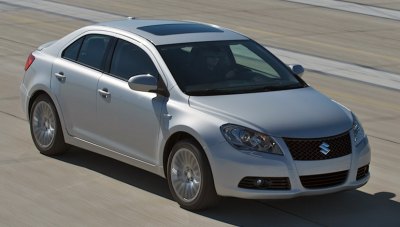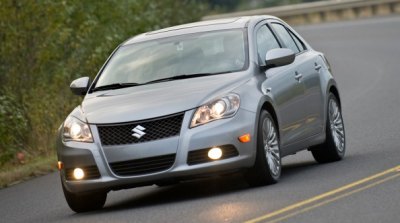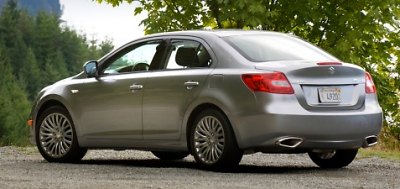Suzuki Kizashi
Debut: 2009 |
||||||||||
We can't help admiring Suzuki. For decades it has been the world's largest manufacturer for small cars. Its sensible market planning and investment ensure it continue to return a profit during credit crunch, a rare achievement in the motor industry. A and B-segment small cars contribute to over 90 percent of its global sales. However, also because of its strong biasing to small cars, it has earned little success in the North America market. In the USA, the most popular segment is D-segment cars like Toyota Camry. Suzuki has never produced a car in this class. A few years ago, It did sell a C/D-segment car called Verona, but it was actually a rebadged Daewoo Magnus rather than its own product. Anyway, the car resulted in dismal sales and died quickly. Having learned the leason, Suzuki knew it had to either stop dreaming of expanding upmarket or increase investmnet to build a really nice car by itself. It chose the latter. In Japanese, "Kizashi" means "a sign of great things to come". Suzuki definitely hopes so. Using a Japanese name on a Japanese car is probably the first good sign. I always don't understand why so many Japanese cars pretend to be Western-born – what Accord ? what Camry ? My name is Kizashi san ! I was born in Japan and my favourite food is sushi – reverting to a local name shows the confidence of Suzuki, or how it wants to distinguish from others.
Yes, the car does look different from others. We won't call it Alfa-beautiful or Audi-elegant, but it certainly has its own character. A wide stance, short overhangs and strong pillars delivers a sporty feel, as do the very large 18-inch alloy wheels shod with 235/45 tires. Look at the dimensions – only 4620 mm long and a 2700 mm wheelbase, it is one of the smallest cars in the D-segment. Suzuki's American sales people said it points to the compact premium side of the spectrum, which means target rivals are Volkswagen Passat and Acura TSX (i.e. European Honda Accord). The Japanese engineers, however, said it benchmarked against BMW and Audi. No wonder they tried to inject a similar sense of solidity in its chassis and the overall build quality, as well as a sporty handling and ride… Once you sit inside the car, you must admire how much work Suzuki has done, considering they practically started from zero. The MacPherson strut front suspension and multi-link rear suspension are dedicated development. The NVH and safety engineering is unprecedented in the company. They must have spent a lot of effort to make a quiet cabin and solid assembly. The dashboard looks plain and there is no fancy technology, but its build quality would not shame a small BMW. The leather seats are good. Dual-zone climate control is a nice offering. Cabin space is better than its exterior dimensions suggested, thanks to the small car expert's know-how in maximizing interior space. People up to 6 ft 2 won't find the rear seats cramped.
Handling and ride is on the sporty side. Thanks to a firmer suspension setup and sportier rubbers than the family car norms, the Kizashi goes nothing like a Camry. Its chassis has good balance for a front-wheel drive sedan, exhibiting little understeer. Roadholding is superb, predictably. Brakes have good feel and ample power. Steering (assisted electrically) is not exactly feelsome, but it is quick and weighty. All signs show that the car is tuned to European taste. Suzuki said it spent a lot of development work worldwide, such as tuning its handling on the country roads in UK and Nurburgring, high-speed testing on Autobahn, brake testing in Swiss Alps and testing the i-4WD system in New Zealand. The i-4WD is similar to the being used in SX4, which utilizes an electromagnetic multiplate clutch to engage the rear wheels in needs. However, it adds more weight than fun, so unless you regularly drive on slippery surfaces, the standard FWD car is the one you need. The ride is predictably on the firm side, but it is not harsh. Noise is reasonably well insulated at motorway speed.
The Kizashi's weakest link is its engine. Suzuki does not have money to develop an all-new engine, so it reworked the existing 2.4-liter four-cylinder 16V on Grand Vitara. In isolation, this is not a bad engine. It has aluminum head and block, twin-balancer shafts, forged pistons and an intake variable valve timing. It is tuned to 185 horsepower at 6500 rpm, considerably more than a 2.4-liter Camry (158hp) but not as powerful or free-revving as Acura TSX 2.4 (200hp). However, benchmark of the class is still Volkswagen Passat's 2.0 TFSI engine with 200 hp and the turbocharged torque of 206 lb-ft from very low rpm. In contrast, the Suzuki big four-banger produces only 170 lb-ft of torque at 4000 rpm. Moreover, it has to haul some 1.5 tons of mass – now blame that solidity and upgraded insulation ! I don't know how Car & Driver achieved 0-60 mph sprint in a miraculous 7.2 seconds. In the real world, 8 seconds-plus are more likely on the 6-speed manual car. If you opt for the Jatco-built CVT, as do most customers in the USA and all in Japan, it will add another 1 or 1.5 second to 0-60. Frankly, such performance is not slow for a base engine. It is slow for a top engine though. Because of the credit crunch and the resultant shrinkened demands, Suzuki abandoned the original plan of a V6 range-topper, which was supposed to make use of GM's 3.6 V6. This mean in the foreseeable future the Kizashi will have one and only one engine. That won't be easy for its survival.
Perhaps this is why Suzuki decided to partner with Volkswagen. Just a few days ago, the Japanese company agreed to sell 20 percent of its stakes to the German. Will this bring a 2.0TFSI or 3.6 VR6 to the Kizashi ? No one knows. What obvious to me is, Suzuki is not easy to expand beyond small cars with its own effort. Even though Kizashi is a good effort, distinguishable from its Japanese rivals yet remains affordable, it won't stand a chance in Europe, where you can easily get a Ford Mondeo or a lower-spec 3-series. Its main market would be the United States, but its chance there seems to be hurt by the lack of a stronger power unit. This is where VW can help. |
||||||||||
| The above report was last updated on 15 Dec 2009. All Rights Reserved. |
| Specifications | ||||||||||||||||||||||||||||||||||||||||||||||||||||||||||||||||||||||||||||||||||||||||
|
||||||||||||||||||||||||||||||||||||||||||||||||||||||||||||||||||||||||||||||||||||||||
| Performance tested by: *C&D, **R&T, ***MT, ****Autocar |
Copyright©
1997-2009
by Mark Wan @ AutoZine




